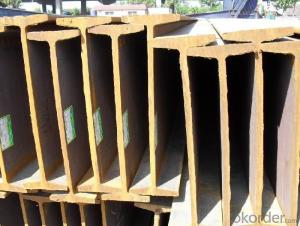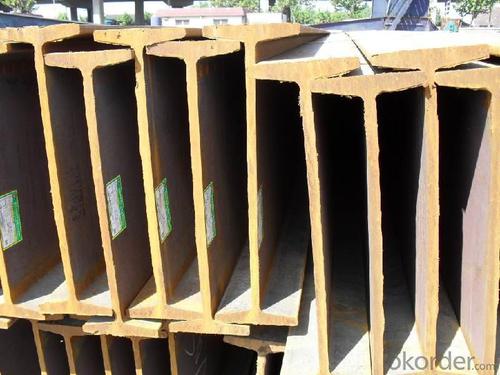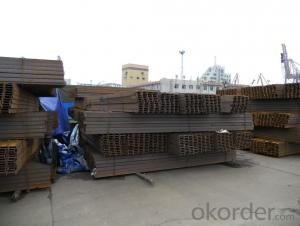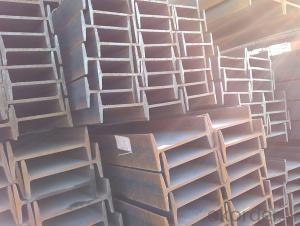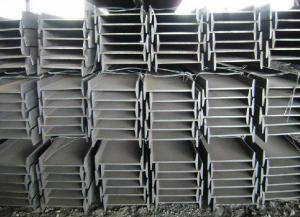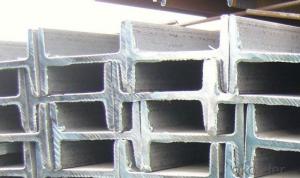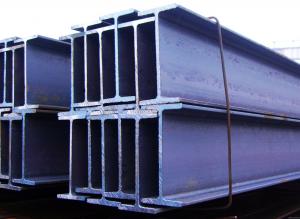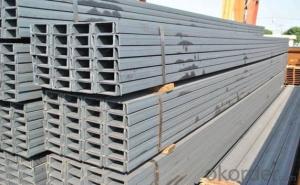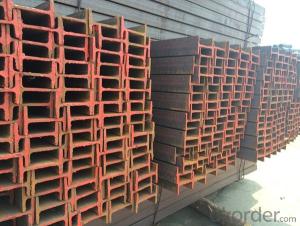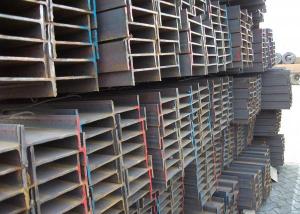Mild Steel I Beams IPE/IPEAA Q235, A36, S235JR
- Loading Port:
- Tianjin
- Payment Terms:
- TT OR LC
- Min Order Qty:
- 25 m.t.
- Supply Capability:
- 200000 m.t./month
OKorder Service Pledge
OKorder Financial Service
You Might Also Like
Specification
Product Description:
OKorder is offering Mild Steel I Beams IPE/IPEAA Q235, A36, S235JR at great prices with worldwide shipping. Our supplier is a world-class manufacturer of steel, with our products utilized the world over. OKorder annually supplies products to European, North American and Asian markets. We provide quotations within 24 hours of receiving an inquiry and guarantee competitive prices.
Product Applications:
Mild Steel I Beams IPE/IPEAA Q235, A36, S235JR are widely used in various construction structures, bridges, autos, brackets, mechanisms and so on.
Product Advantages:
OKorder's Mild Steel I Beams IPE/IPEAA Q235, A36, S235JR are durable, strong, and resist corrosion. The goods is produced from the steel billets of high quality. And can be used widely.
Main Product Features:
· Premium quality
· Prompt delivery & seaworthy packing (30 days after receiving deposit)
· Corrosion resistance
· Can be recycled and reused
· Mill test certification
· Professional Service
· Competitive pricing
Product Specifications:
1. Product name: Mild Steel I Beams IPE/IPEAA Q235, A36, S235JR
2. Production Standard: EN10025, GB Standard, ASTM, JIS etc.
3. Steel Grade: Q235B, A36, S235JR, Q345, SS400 or other equivalent.
4. Length: 5.8M, 6M, 9M, 10M, 12M or as your requirements
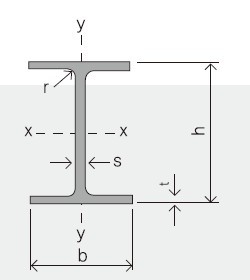
Section | Standard Sectional Dimensions(mm) | ||||
h | b | s | t | Mass Kg/m | |
IPE80 | 80 | 46 | 3.80 | 5.20 | 6.00 |
IPE100 | 100 | 55 | 4.10 | 5.70 | 8.10 |
IPE120 | 120 | 64 | 4.80 | 6.30 | 10.40 |
IPE140 | 140 | 73 | 4.70 | 6.90 | 12.90 |
IPE160 | 160 | 82 | 5.00 | 7.40 | 15.80 |
IPE180 | 180 | 91 | 5.30 | 8.00 | 18.80 |
IPE200 | 200 | 100 | 5.60 | 8.50 | 22.40 |
IPE220 | 220 | 110 | 5.90 | 9.20 | 26.20 |
IPE240 | 240 | 120 | 6.20 | 9.80 | 30.70 |
IPE270 | 270 | 135 | 6.60 | 10.20 | 36.10 |
IPEAA80 | 80 | 46 | 3.20 | 4.20 | 4.95 |
IPEAA100 | 100 | 55 | 3.60 | 4.50 | 6.72 |
IPEAA120 | 120 | 64 | 3.80 | 4.80 | 8.36 |
IPEAA140 | 140 | 73 | 3.80 | 5.20 | 10.05 |
IPEAA160 | 160 | 82 | 4.00 | 5.60 | 12.31 |
IPEAA180 | 180 | 91 | 4.30 | 6.50 | 15.40 |
IPEAA200 | 200 | 100 | 4.50 | 6.70 | 17.95 |
5.Color marking: There will be color marking on both end of the bundle for the cargo delivered by bulk vessel. That makes it easily to distinguish at the destination port.
Tag mark: there will be tag mark tied up on the bundles. The information usually including supplier logo and name, product name, made in China, shipping marks and other information request by the customer.
If loading by container the marking is not needed, but we will prepare it as customer request.
6. Shipment Items: By containers or by bulk cargo. Depends on customers
FAQ:
Q1: Why buy Mild Steel I Beams IPE/IPEAA Q235, A36, S235JR China from OKorder.com?
A1: All products are carefully selected from China's most reliable manufacturing enterprises. Through its ISO certifications, OKorder.com adheres to the highest standards and a commitment to supply chain safety and customer satisfaction. We can guarantee the quality!
Q2: The products are invoicing on theoretical weight or on actual weight?
A2: We can do it in both manners, it’s according to buyer's requirement.
Q3: Can you offer the third part inspection certificates ?
A3: Yes, we can apply third part inspection before shipping, such as SGS, BV, etc .
Images:
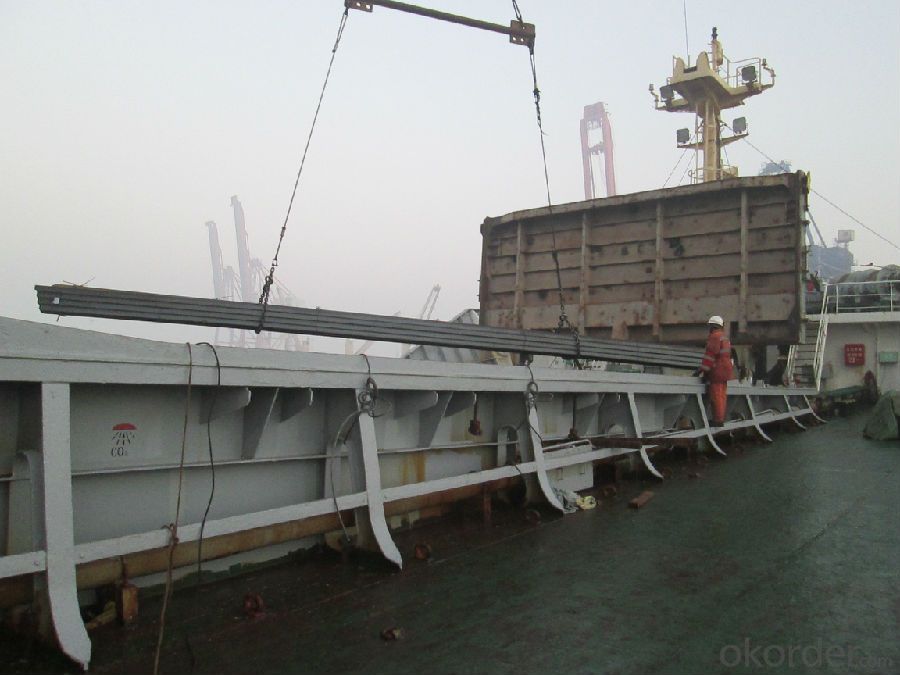
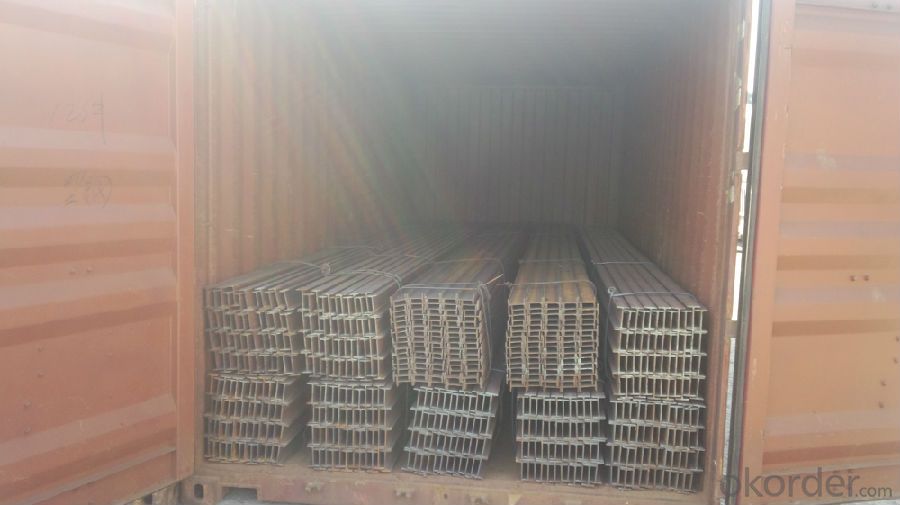
- Q: Can steel I-beams be used in industrial or heavy-duty construction projects?
- Yes, steel I-beams are commonly used in industrial and heavy-duty construction projects. They are a popular choice due to their strength, durability, and versatility. Steel I-beams have the ability to support heavy loads and provide structural stability, making them ideal for constructing large buildings, bridges, warehouses, and other industrial structures. Additionally, their high strength-to-weight ratio allows for longer spans and reduced need for support columns, providing more open and flexible spaces. Steel I-beams can also be easily customized to fit specific project requirements and are resistant to various environmental factors such as fire, corrosion, and pests. Overall, steel I-beams are a reliable and efficient choice for industrial and heavy-duty construction projects.
- Q: What are the different types of steel I-beam connections for cantilever structures?
- For cantilever structures, there are various types of steel I-beam connections that are commonly used, each offering distinct benefits and suitability for specific applications. Some of the frequently utilized connections are as follows: 1. Welded Connection: The most common and straightforward method is to directly weld the end of the beam to the supporting structure. This provides exceptional rigidity and strength. However, skilled welding professionals are required, and residual stresses may occur. 2. Bolted Connection: This connection involves securing steel plates with holes to the ends of the I-beams using bolts, which are then fastened to the supporting structure. Bolted connections offer easy installation, adjustability, and the option to disassemble and reuse the structure if necessary. However, they may have some flexibility and require regular inspection and bolt tightening. 3. Cleat Connection: A cleat connection entails welding a steel plate with holes to the end of the I-beam, which is then bolted to the supporting structure. This connection combines the advantages of both welding and bolting, providing high strength and adjustability. Cleat connections are commonly employed in large cantilever structures due to their robustness and versatility. 4. Moment Connection: This type of connection is specifically designed to transfer bending moments between the I-beam and the supporting structure. Moment connections often involve welding stiffeners or plates to the flanges and web of the beam, creating a rigid joint. These connections are ideal for structures subjected to substantial loads and moments, such as bridges or heavy industrial applications. 5. Shear Connection: Shear connections primarily transfer vertical loads between the I-beam and the supporting structure. These connections typically involve welding or bolting steel plates to the flanges and webs of the beam, providing excellent load-bearing capacity. Shear connections are commonly utilized in cantilever structures where heavy vertical loads need to be supported. When selecting the appropriate steel I-beam connection for a cantilever structure, it is crucial to consider the specific requirements and load conditions. Consulting with a structural engineer or experienced professional is highly recommended to ensure the optimal connection method is chosen for the specific application.
- Q: Are steel I-beams suitable for supporting large spans?
- Yes, steel I-beams are suitable for supporting large spans. They are commonly used in construction due to their high strength-to-weight ratio, which allows them to bear heavy loads over long distances without sagging or buckling. Steel I-beams provide excellent structural support and are often employed in the construction of bridges, high-rise buildings, and industrial structures where large spans need to be supported.
- Q: What are the factors to consider when calculating load capacity for steel I-beams?
- When calculating the load capacity for steel I-beams, there are several factors that need to be considered. These factors include the material properties of the steel, the dimensions and shape of the beam, the support conditions, and the applied loads. 1. Material properties: The type and grade of steel used for the I-beam will determine its strength and stiffness. Different steel alloys have varying tensile and yield strengths, which directly affect the load capacity. It is crucial to know the properties of the steel to accurately calculate the load capacity. 2. Beam dimensions: The dimensions of the I-beam, such as its depth, width, and thickness, play a significant role in determining its load capacity. A larger and thicker beam will generally have a higher load-carrying capacity. The beam's cross-sectional shape also needs to be considered, as it affects the beam's moment of inertia and its resistance against bending. 3. Support conditions: The way the I-beam is supported at its ends or along its span greatly influences its load capacity. The beam can be supported in various ways, such as simply supported, fixed at both ends, or continuous over multiple supports. The support conditions determine the maximum bending moment and shear forces the beam can withstand. 4. Applied loads: The loads exerted on the I-beam, including dead loads, live loads, and other dynamic loads, need to be accurately determined. Dead loads refer to the weight of the structure itself and any permanent fixtures, while live loads represent temporary or variable loads like people, furniture, or equipment. The magnitude, distribution, and duration of these loads must be considered to calculate the load capacity accurately. 5. Deflection criteria: Depending on the intended use of the I-beam, deflection criteria may also need to be considered. If the beam is expected to support sensitive equipment, excessive deflection could cause operational issues. The acceptable deflection limits must be taken into account while calculating the load capacity. Considering these factors is crucial when calculating the load capacity for steel I-beams. It is essential to consult relevant design codes and standards, such as the American Institute of Steel Construction (AISC) Manual, to ensure accurate calculations and safe structural design.
- Q: What are the different load types that steel I-beams can withstand?
- Steel I-beams can withstand various load types, including dead loads, live loads, and wind loads. Dead loads refer to the weight of the structure itself, as well as any permanent fixtures or materials. Live loads are dynamic loads caused by occupants, furniture, or any temporary loads that may be imposed on the structure. Wind loads, on the other hand, are forces exerted by wind that can vary in magnitude and direction. Steel I-beams are designed to handle these different load types and provide structural support and stability.
- Q: How are steel I-beams protected against UV radiation?
- Steel I-beams are typically protected against UV radiation through the application of an appropriate coating or paint system. These coatings are designed to act as a barrier, preventing direct exposure of the steel to UV rays, which can cause oxidation and degradation over time. Additionally, some coatings may contain UV inhibitors or pigments that reflect or absorb UV radiation, further enhancing the protection.
- Q: What are the considerations for waterproofing when using steel I-beams?
- When it comes to waterproofing steel I-beams, there are a number of important factors that need to be considered. First and foremost, it is absolutely vital to make sure that the steel beams are properly coated or treated in order to prevent corrosion. Steel is susceptible to rust and degradation when exposed to moisture, so it is crucial to apply a high-quality protective coating or treatment to the surface of the beams. This will help to maintain their structural integrity and prevent water from seeping into the material. Another aspect that needs to be taken into account is the connection points between the steel beams and other structural elements, such as walls or floors. These connection points must be carefully sealed in order to prevent any water from infiltrating. The use of waterproof sealants or gaskets at these junctions can help create a watertight barrier and prevent any potential leaks. Additionally, it is important to ensure that the design and construction of the building incorporate proper drainage systems to redirect water away from the steel beams. This can involve the installation of gutters, downspouts, and appropriate slope in the surrounding landscape to ensure proper water runoff. By effectively managing the flow of water, the risk of water pooling or accumulating around the steel beams is minimized. Furthermore, it is essential to take into consideration the possibility of condensation forming on the steel beams. When warm air comes into contact with cold surfaces, condensation can occur, leading to the build-up of moisture. To prevent this, it is necessary to install proper insulation to maintain a consistent temperature and minimize temperature differences that could cause condensation. Adequate ventilation should also be provided to allow any trapped moisture to escape. Lastly, regular inspection and maintenance are key to ensuring the long-term waterproofing of steel I-beams. Periodic checks should be carried out to identify any signs of water damage, corrosion, or leaks. If any issues are detected, such as the need to reapply coatings, reseal connection points, or address drainage problems, prompt repairs should be undertaken. In conclusion, when waterproofing steel I-beams, it is essential to address the risk of corrosion, seal connection points, manage water drainage, prevent condensation, and conduct regular maintenance. By taking these factors into consideration, the structural integrity of the steel beams can be preserved, ensuring the long-lasting durability of the overall construction.
- Q: What is the cost of steel I-beams compared to other structural beams?
- The cost of steel I-beams can vary depending on various factors, including the specific type and size of the beam, the supplier, location, and current market conditions. When compared to other structural beams like wood, concrete, or aluminum, steel I-beams generally have a higher upfront cost. However, the long-term benefits of steel I-beams often outweigh the initial investment. One advantage of steel I-beams is their superior load-bearing capacity. This allows for larger spans and fewer support columns, resulting in cost savings in terms of material and labor. Additionally, steel I-beams are highly resistant to fire, pests, and natural elements, reducing the need for maintenance and repairs. This durability leads to long-term cost savings and a longer overall lifespan compared to other beam materials. It is important to note that the cost of steel I-beams can be affected by market fluctuations in raw material prices, transportation costs, and regional demand. Therefore, it is recommended to consult with multiple suppliers and contractors to obtain accurate and up-to-date pricing information for specific projects. In conclusion, despite the higher initial cost, steel I-beams are a cost-effective choice for construction projects due to their strength, durability, and long-term cost savings.
- Q: Can steel I-beams be used in renovation or retrofitting projects?
- Yes, steel I-beams can be used in renovation or retrofitting projects. They are commonly used for structural support and can be an effective solution when reinforcing or upgrading existing buildings or structures. Steel I-beams provide strength and stability, making them suitable for various renovation and retrofitting applications.
- Q: Can steel I-beams be used for educational institutions such as schools or universities?
- Educational institutions, such as schools and universities, can utilize steel I-beams. These beams are widely employed in the construction industry because of their robustness and longevity. They provide essential structural support and can bear heavy loads, making them ideal for large buildings like educational institutions. Steel I-beams offer numerous benefits for educational institutions. Firstly, they enable the creation of spacious areas, like gymnasiums or auditoriums, without the need for excessive support columns. This maximizes the usable space, which is especially advantageous for schools and universities that require versatile areas for various activities. Moreover, steel I-beams possess fire-resistant properties, which is crucial for the safety of educational institutions. They have a high melting point and do not contribute to the spread of flames, thereby creating a safer environment for students and staff. Additionally, steel I-beams are highly customizable and can be tailored to meet specific design requirements. This allows for the construction of aesthetically pleasing and contemporary educational facilities, incorporating features such as large windows, open floor plans, and innovative architectural designs. Furthermore, steel is a sustainable material as it can be recycled and repurposed at the end of its life cycle. This aligns with the increasing emphasis on environmentally friendly construction practices in educational institutions. To conclude, steel I-beams are a suitable choice for educational institutions like schools or universities due to their strength, durability, fire resistance, and design flexibility. Utilizing these beams can result in the construction of safe, modern, and sustainable educational facilities that cater to the evolving needs of students and staff.
Send your message to us
Mild Steel I Beams IPE/IPEAA Q235, A36, S235JR
- Loading Port:
- Tianjin
- Payment Terms:
- TT OR LC
- Min Order Qty:
- 25 m.t.
- Supply Capability:
- 200000 m.t./month
OKorder Service Pledge
OKorder Financial Service
Similar products
Hot products
Hot Searches
Related keywords
